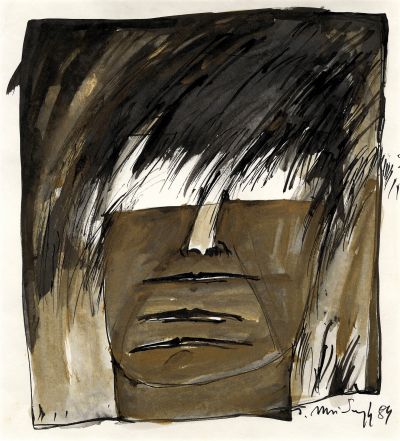Janina Musiałczyk. W drodze, on the road
Mediathek Sorted




































































































Musiałczyk depicted her emotional connection to houses and apartments at different temporal periods and in different picture series of her paintings and drawings. In 1993, closely linked to the themes surrounding flight and migration, she depicted people with handcarts walking along winding, spiral, upside-down paths in her series “Coming, Becoming, Going” (Kommen, werden, gehen) (Fig. 32–39, 42). The carts bear houses and entire towns, which the people carry with them as the ballast of memory. However, burdensome memories also include people who are tied firmly to backs, are fettered and pulled behind the walkers in long rows, dragged behind as a seated piece of baggage, or, ill and dying, are laid down in the cart together with the houses and towns. There are boarded up windows and doors on houses that are abandoned when the people leave, or which remain locked when they arrive.
In 1995/96, in the “Meetings on the Road” (Begegnungen unterwegs) series, she drew figures carrying entire towns on their backs and chest (Fig. 1). Others have formed pairs to set their house on wheels for their journey (Fig. 69) or draw it along with them as a side cart (Fig. 68) or balance it on their arm (Fig. 67), while at the same time juggling with wheels, which should ordinarily be helping them to move forward more quickly. All metaphors for an existence that fluctuates between moving and staying. Even in the third series, produced in 2012, the artist depicts a couple facing each other in an intimate pose, the male figure of which carries the house of his childhood and youth with him as a heavy burden (Fig. 51).
In the series “On the Road” (Unterwegs), we meet single figures and couples in large-format acrylic paintings who have set out on their journey crammed into houses, or in rooms set onto wheels, in prisons of their memory (Fig. 5, 6). In a later drawing in this same series (1998, Fig. 63), a giant-like female figure, who stands tall and self-assured, who walks through the landscape in heavy shoes, pulls a tiny house on wheels, which contains her homeland or precious memories, as a constant adjunct.
During that period, in a series of paintings and ink drawings called “It Teeters” (Es taumelt), the artist also produced images of houses and churches precariously stacked one on top of the other,[11] which remind the viewer of the pictorial world created by Marc Chagall. In paintings produced before the first world war, like his etchings in the “My Life” (Mein Leben) series (1922/23) produced after his emigration to Berlin, Chagall portrayed the everyday world of his home town of Vitebsk, the Jewish suburbs, and Russian villages. In these works, houses, streets, furnished interiors, and people float and knock against each other in an ordered chaos, and in so doing, become anchors of memory: “It seems to me that, far away from home, I was closer to that place, closer than many others who lived there...”[12] In his “Self-Portrait”[13], he too balances his parental home on his head: “Churches, fences, synagogues all around, simple and eternal like the buildings on the frescoes by Giotto [...] Here, on Pokrovskaya Street, I was born a second time”.[14]
The drawings produced by Musiałczyk for the Es taumelt series have a more dramatic impact, however. Haggard human figures, stiff with horror yet also in a state of high agitation, stand and lie on top of each other against the backdrop of a town. Their sturdy shoes and the wheels strapped on underneath indicate the start of emigration. The chimneys of the town smoke ominously (Fig. 40). Buildings disappear into the sky as though in an explosion; a ladder that has been put up leads to nothing but emptiness (Fig. 41). A face screaming in panic, forced into a black space, is set upon and tortured by rolling and flying wheels (Fig. 44).
“In art, the house is usually a metaphor for the space closest to the person, a symbol of refuge and protection”, writes the Hamburg-based Slavicist, Waldemar Klemm: “Here, however, carried on the person’s own back or in their baggage, as a trace of the past, something that is genuinely their own, it can also be a burden which makes movement more difficult, a space that is too narrow for the figures that are crammed into it, or something that is separate from the person, something they are unable to access. [...] After all, the most characteristic drawings are those in which the silhouettes are placed in rooms, similar to cages, finally and completely, not without having themselves contributed to it, abandoning themselves to the isolation in the house as prison”.[15]
[11] From the series “It Teeters” (Es taumelt), 1994, pen and black ink, 29 x 40 cm; from the series Es taumelt, 1996, acrylic on canvas, 60 x 70 cm (two images with the same title, front and rear side); Es taumelt, 1994, pen and black ink, 29 x 40 cm; all in: Janina Musiałczyk: Zeichnungen und Bilder, Hamburg/Łódź 1998, No. 1–3, 20.
[12] Quoted from Ernst-Eberhard Güse: Die Radierungen zu “Mein Leben”, in: Marc Chagall. Druckgraphik, published by Ernst-Eberhard Güse, Stuttgart 1985, page 16.
[13] Marc Chagall: Self-Portrait, 1922, from the series “My Life”, sheet 17, etching and drypoint, 27.5 x 21.5 cm (Kornfeld 17); see Güse 1985 (see note 12), Fig. 17, page 32. See also the single sheet, “Self-Portrait with House in Face”, 1922/23, etching and drypoint, 17.5 x 14.6 cm (Kornfeld 30), ibid., Fig. 274, page 244.
[14] Marc Chagall: Mein Leben, Stuttgart 1959, page 6 [My Life, London 1965].
[15] Waldemar Klemm: “Die Kunst von Janina Musiałczyk ist figurativ …”, in: Zeichnungen und Bilder 1998 (see note 11), after No. 2.





















































































